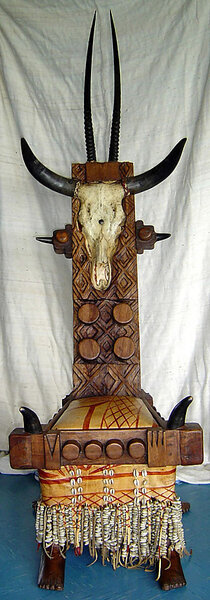The trash of life is Elias Sime's art
Loading...
| Santa Monica, Calif.
In a tiny corner of the sprawling Los Angeles metropolis, a newly discovered artistic voice is speaking softly but articulately in a show that is being "heard" as far away as Addis Ababa and Vienna. Ethiopian artist, Elias Sime, who works with the humblest of materials – think mud, bottle caps, yarn, and buttons – in his first solo US exhibition, "Elias Sime: Eye of the Needle, Eye of the Heart" at the Santa Monica Museum of Art (SMMoA), appears to be a global art star in the making.
"He is one of the great sacred artists of our time," says art impresario Peter Sellars, who co-curated the show.
"He's incredibly talented," says SMMoA director, Elsa Longhauser, who calls him a "world artist" whose work transcends easy ethnic or geographic labels.
Enter the boutique museum space, which nestles in a converted subway station, and in the words of filmmakers Valerie Faris and Jonathan Dayton ("Little Miss Sunshine"), "you immediately feel the power and love and connection Elias has to his materials and his community." Among the 56 works culled from his 20-year career: a series of meticulously decorated goatskins; large canvases featuring a range of "found" materials such as threads, buttons, and bottle caps in both abstract and realistic designs; a parade of tiny monkeys, frogs, and TV sets made of mud; and carved walking sticks.
The pièce de résistance is a series of elaborately carved thrones, decorated with animal skulls, shells, and carvings. The married duo, Ms. Faris and Mr. Dayton, spent their 20th anniversary filming a minidocumentary that has become the exhibition's Catalog and plays continuously in a viewing room. The film reveals Sime as an artist deeply rooted in his local culture. His passion project is an ambitious house that he is constructing from mud and straw and more than a community's worth of creativity, participation, and everyday objects. The team follows Sime through the local Addis Ababa market – one of the largest bazaars in Africa – as he trolls for artifacts and he's seen with local children who scour the byways of the city to find throwaway treasures for his works.
"He is a local hero," says Faris, who adds that the works he creates show the same love, patience, and connection to community that he embodies in his own life. For instance, she says, the sheer time required for the voluminous amount of needlework in many works radiates a message of care.
"There is no such thing as trash for Elias," says Mr. Sellars, who first championed the artist two years ago when he produced a show in Vienna as part of the city's celebration of Mozart's 250th birthday. "Everything is part of the larger interconnectedness of our world for him." Sime is not a religious artist in a conventional tradition of pious imagery, but rather in the way in which he elevates and cherishes the everyday, Sellars says. "These things all have history, stories, and life which he honors when he uses them."
While the ordinariness of the materials might lead some to relegate the work to the level of craft or folk art, that would be a mistake, says SMMoA's Ms. Longhauser. "This is very knowing art," she says, pointing to the sophistication of the designs as well as the techniques.
Indeed, Sellars says, during the Vienna festival, Sime's work involved creating new troughs of fresh mud daily, which he did in a performance space. Elias dressed for the occasion, and one day he even wore a three-piece suit. "The children loved that," Sellars says.
The artist attended design school in Addis Ababa, not by choice but because the school, then under Russian administration, assigned students an area of study. But once he emerged, he began to explore his artistic inclinations. Early works, such as a collage depicting the sort of mobile grocery store once common in Ethiopia, show his affection for recycled materials (his signature is hidden in a bottle cap).
Sime's affinity for found objects is not ironic in the tradition of Western artists such as Marcel Duchamp, who framed a toilet as a satiric statement about notions of art. Rather, says Sellars, his appreciation for the possibilities of his environment is a spirit he shares with other African artists who, adds art critic Edward Goldman, do not have the luxury of waste.
Peter Clothier, a British critic and former dean of the Otis College of Art and Design in Los Angeles, calls Sime a modern shaman, an artist who understands the spiritual connection between life and art.
"At once primitive in their magic and intensely contemporary in aesthetic sophistication," he says of the works, which might suggest a clash of cultures. Or, he says, "the lost mysterious connection between the primitive and the sophisticated. Between the animate and inanimate, nature and artifact. All this and more, wherever your mind can wander with it."
While the exhibit has elicited a strong critical welcome from some, Mr. Goldman takes a wait-and-see attitude. He notes that interest in the art world for works coming from Africa is very high at the moment. He points out that Nigerian artist El Anatsui was one of the stars of this fall's Venice Biennale. Sime is not yet of that caliber, but, Goldman says, "he has promise."
UCLA's Fowler Museum director Marla Berns points out that this is a momentous first step. "A career retrospective in a major city is an important opportunity for an emerging artist," she says.
Sime's thrones are slated to appear in a special final performance by the Los Angeles Philharmonic departing conductor Esa-Pekka Salonen in April. On the program: Igor Stravinsky, an early 20th-century modernist, whose work, says Sellars who is directing the event, was greatly influenced by African art.






